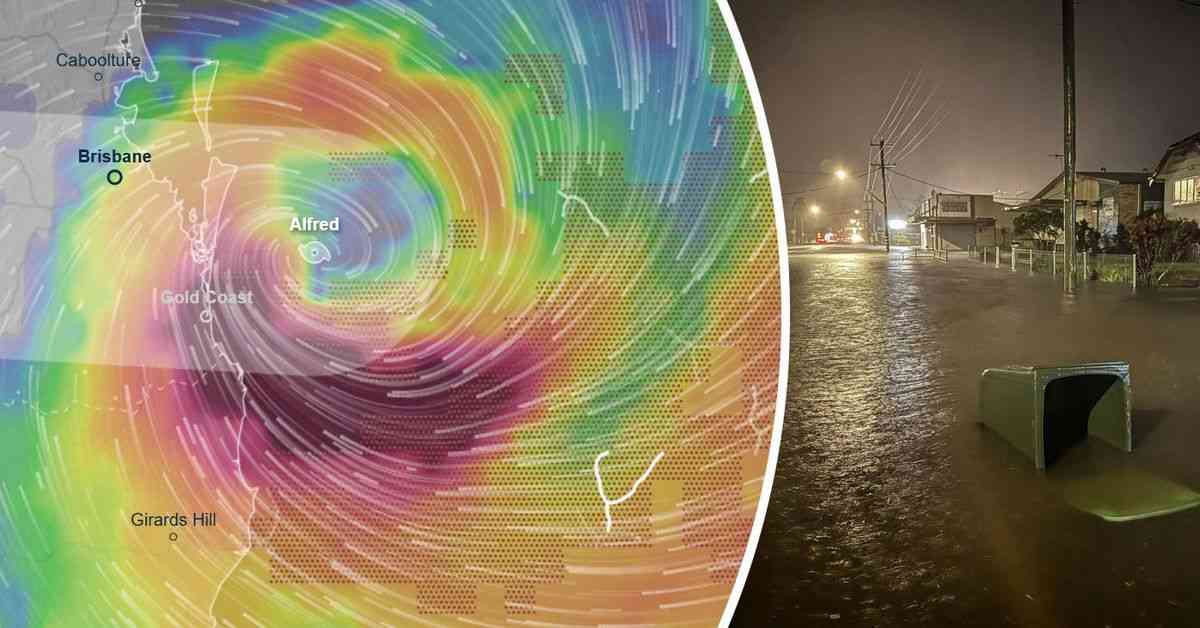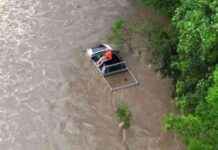A powerful storm has unleashed its fury on the Moreton Bay islands, leaving a trail of destruction in its wake. Cyclone Alfred, though slightly weakened, delivered intense rain and wind gusts of up to 120km/h as it headed towards the mainland Queensland coast. With more than 230,000 people plunged into darkness, the category 1 storm wreaked havoc by forcing trees into homes, downing powerlines, and unleashing life-threatening flooding rains.
The storm’s impact was deeply felt by residents across the region as they grappled with the onslaught of nature’s wrath. In the face of the approaching storm, more than 4 million residents in south-east Queensland and northern NSW braced themselves for the impending disaster. Floodwaters engulfed areas, leaving Brisbane residents seeking refuge in the sturdiest parts of their homes, while residents of Currumbin Valley found themselves stranded and isolated by the fast-moving and unpredictable floods.
As the storm bore down on the coast, meteorologists closely monitored its progress, predicting its landfall near Bribie Island, north of Brisbane. Although the storm weakened slightly to a category 1, it continued to pose a significant threat with wind gusts of up to 120km/h and the potential to dump 350 to 450 millimeters of rain in the worst-affected areas. While the destructive 155km/h wind gusts were no longer anticipated, the relentless rain remained a cause for concern.
Residents Urged to Seek Shelter Amidst Chaos
Authorities issued emergency warnings to millions of residents in the Moreton Bay region and beyond, urging them to seek shelter and secure themselves in the safest parts of their buildings. Brisbane residents were advised to stay away from windows and take refuge in interior spaces, such as bathrooms, walk-in wardrobes, or hallways. In Currumbin Valley, evacuation routes were closed, leaving residents with no option but to weather the dangerous flooding conditions.
The storm’s impact was already evident well before it made landfall, as it tore through the Gold Coast, knocking out power to nearly 200,000 homes and businesses in south-east Queensland and an additional 40,000 in northern NSW. Energex reported their efforts to restore power to affected properties throughout the day, but only in emergency situations deemed safe for their crews to operate. The company emphasized the hazardous conditions posed by cyclonic weather, highlighting the need for caution in the face of ongoing risks.
Despite the preparations and warnings issued ahead of the storm, tragedy struck when a man’s vehicle was swept away by floodwaters near Coffs Harbour. Despite managing to communicate with authorities while clinging to a tree branch, the man was tragically swept away beneath the water’s surface, prompting a search operation to locate him. The incident served as a grim reminder of the dangers posed by flooded roadways and the importance of heeding evacuation orders.
Residents Face Devastation and Evacuations
As the storm raged on, residents across the Gold Coast bore witness to its ferocity, with wind gusts exceeding 100km/h and trees uprooted by the force of nature. Homes were not spared from the storm’s wrath, as roofs caved in and structures were damaged by falling debris. In Mudgeeraba, a woman narrowly escaped injury when a tree crashed through her roof in the early hours of the morning, forcing her to brace the ceiling to prevent its collapse.
The threat of flooding loomed large as Cyclone Alfred transitioned into a tropical low, unleashing relentless rains across the region. Major rivers were expected to swell, posing a risk to communities along their banks. Authorities issued evacuation orders for more than 15,000 people in northern NSW, particularly in Lismore, where the potential for widespread flooding was imminent. Despite the challenges posed by the storm, emergency services remained vigilant in their response efforts, working tirelessly to ensure the safety and well-being of residents.
As the storm continued its destructive path, communities braced themselves for the aftermath of Cyclone Alfred. With the threat of flooding and further rainfall looming large, residents remained on high alert, ready to face the challenges posed by the natural disaster. While the storm may have passed, its impact would be felt for days to come, underscoring the resilience and strength of communities in the face of adversity.

















